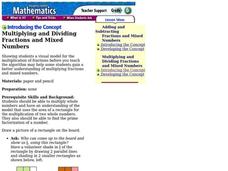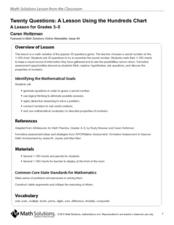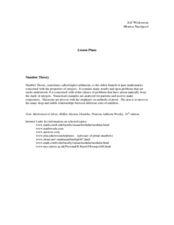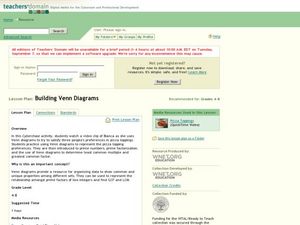Curated OER
Perfect Numbers
Sixth graders classify numbers as abundant, deficient, or perfect based on the relationship between the number and its factors. They review factor game using the completed lab sheet. When playing the factor game which type of numbers...
Curated OER
Multiplying and Dividing Fractions and Mixed Numbers
Help math learners discover how to multiply fractions and mixed numbers. They will explore visual examples of the operations. They also practice solving problems that their instructor models.
Curated OER
Prime Factorization
Sixth graders participate in a lesson that focuses on the concept of finding the prime factorization of a number. They write the answer using exponential notation. Students play a game of Bingo to keep engaged during the lesson.
Curated OER
Prime and Composite Numbers
Sixth graders investigate the concept of prime and composite numbers. They use a review of multiplication to help explain factoring. Students are taught the definition of a prime and composite number and then practice independently.
Curated OER
Modeling Prime Factorization
Students model factors using tiles and grid paper. They differentiate between prime and composite factor trees. Students illustrate prime factorization using factor trees. They are given 12 tiles or cut-out paper squares. Students...
Curated OER
Solving Math Problems In the Real World
Upper elementary and middles schoolers discuss and solve real world applications of math. They use formulas for volume and percents to answer real world questions. In the second part of the lesson, groups write and solve word problems....
Curated OER
Prime and Composite Numbers, Prime Factorization
Middle schoolers research prime and composite numbers. With a partner, students use graph paper to draw rectangles of various sizes. They list the dimensions of rectangles and discuss how the dimensions relate to the factors of each...
Curated OER
Prime Factorization
In this math worksheet, students find the solutions to the problems while looking for the prime factors. There is an example at the top of the page.
Curated OER
Prime and Composite Numbers
Eighth graders explore prime and composite numbers. Given division problems, they use color tiles to model solutions to division problems. Through activities and observation, 8th graders discover the meaning of prime and composite...
Curated OER
Twenty Questions: The Hundred Chart
Use the 20 Questions game to practice math vocabulary and number properties! Project a hundreds chart and hand one out to learners. Ideally, give them counters (beans would work well) to mark off the chart so you can play multiple times....
Curated OER
Prime Factors
Fifth graders review the concept of prime factorization. Then, they use the rules for divisibility and other notions to find the prime factorization of unfamiliar numbers. They solve problems in a whole class setting.
Curated OER
Transition to algebra
Students recognize the difference between a prime and a composite number. In this prime and composite number lesson, students use a factor tree model to show prime factorization. Students participate in a bingo activity....
Curated OER
Factor Game (Number Theory)
Middle schoolers use a Factor Board game to identify the properties of prime, composite, abundant, deficient and perfect numbers. The game is comprised of the numbers from 1 to 30 placed in a 5 by 6 grid. Pupils figure out they can score...
Curated OER
Introducing the Concept Prime Factors
Fifth graders identify the prime factorization for 48 using different sets of factors. They find the prime factorization for 60.
Curated OER
Mathematics: Prime and Composite Numbers
Sixth graders explore how to apply the commutative property and the rules of divisibility. They examine the difference between prime and composite numbers.
Curated OER
Number Theory
Learners explore the concept of number theory. They discuss an assortment of number theory topics such as prime numbers, composite numbers, GCF, modular arithmetic, and others in a lecture style discussion. Pupils view videos about these...
Curated OER
Prime and Composite Numbers
Students identify prime and composite numbers. In this prime and composites lesson plan, students are given the rules for identifying prime and composite numbers by the teacher, who gives examples on the board. Individuals then complete...
Curated OER
Factors, Divisibility, and Relatively Prime
Seventh graders explore the concept of divisibility. In this divisibility lesson, 7th graders use divisibility rules to find factors of numbers. Students create foldables to illustrate divisibility rules.
Curated OER
Prime and Composite Numbers with use of manipulatives (Elementary, Mathematics)
Students learn what prime and composite numbers are. They learn how to identify them by working in a group and demonstrating an understanding of one work problem with 100% accuracy using the manipulatives provided.
Curated OER
Prime Factorization
In this math worksheet, students find the solutions to the whole numbers through finding the prime factorization. This could be done using number trees.
Curated OER
Mission: Finding the LCM using Prime Factorization
In this prime factorization worksheet, students find the least common multiple of the given pair of numbers using factor trees. Students solve 10 problems.
Curated OER
Building Venn Diagrams
Students use Venn diagrams to solve prime number and factorization problems. In this multiplication lesson, students watch a video and use a Venn Diagram to help them solve a pizza math activity that uses prime factorization. Students...
Curated OER
Sets and the Venn Diagram
Young scholars review number sets and complete a Venn Diagram for number sets. For this number sets lesson, students review integers, whole numbers, and elements. Young scholars use computers to create a Venn Diagram for number sets....
Curated OER
Number Line Mathematics
Students translate problem situations into diagrams, models, and numerals using whole numbers, fractions, mixed numbers, decimals, and percents. They identify that numbers in different forms are equivalent or not equivalent using whole...























